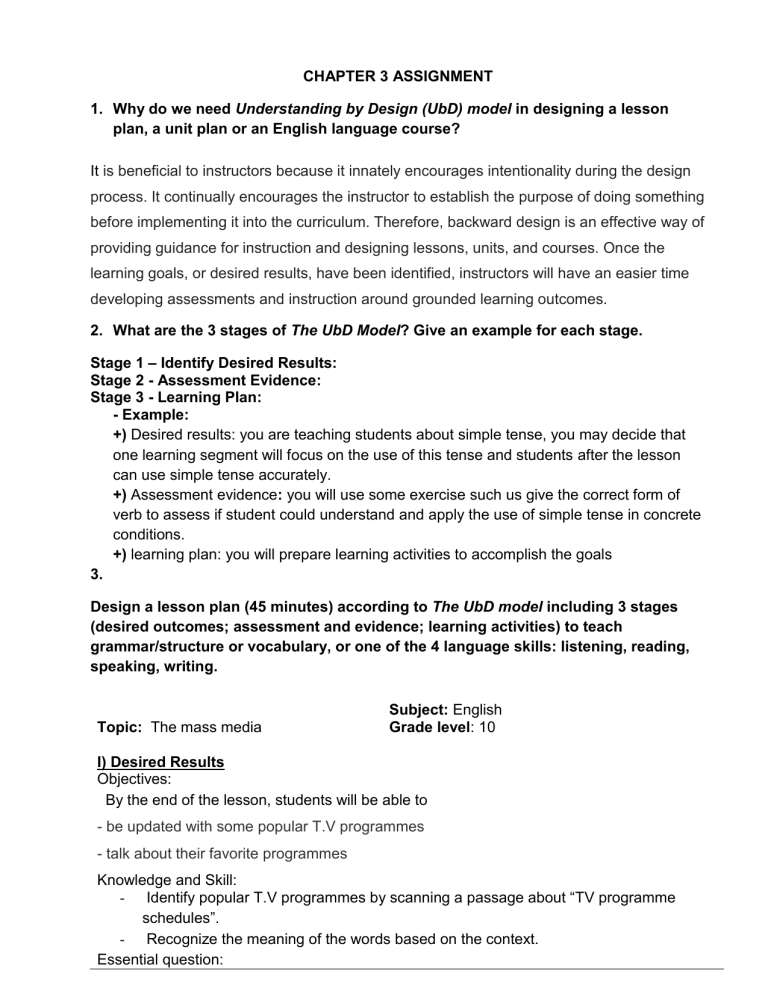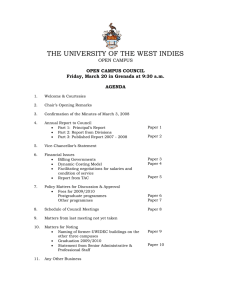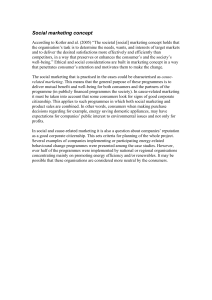
CHAPTER 3 ASSIGNMENT 1. Why do we need Understanding by Design (UbD) model in designing a lesson plan, a unit plan or an English language course? It is beneficial to instructors because it innately encourages intentionality during the design process. It continually encourages the instructor to establish the purpose of doing something before implementing it into the curriculum. Therefore, backward design is an effective way of providing guidance for instruction and designing lessons, units, and courses. Once the learning goals, or desired results, have been identified, instructors will have an easier time developing assessments and instruction around grounded learning outcomes. 2. What are the 3 stages of The UbD Model? Give an example for each stage. Stage 1 – Identify Desired Results: Stage 2 - Assessment Evidence: Stage 3 - Learning Plan: - Example: +) Desired results: you are teaching students about simple tense, you may decide that one learning segment will focus on the use of this tense and students after the lesson can use simple tense accurately. +) Assessment evidence: you will use some exercise such us give the correct form of verb to assess if student could understand and apply the use of simple tense in concrete conditions. +) learning plan: you will prepare learning activities to accomplish the goals 3. Design a lesson plan (45 minutes) according to The UbD model including 3 stages (desired outcomes; assessment and evidence; learning activities) to teach grammar/structure or vocabulary, or one of the 4 language skills: listening, reading, speaking, writing. Topic: The mass media Subject: English Grade level: 10 I) Desired Results Objectives: By the end of the lesson, students will be able to - be updated with some popular T.V programmes - talk about their favorite programmes Knowledge and Skill: - Identify popular T.V programmes by scanning a passage about “TV programme schedules”. - Recognize the meaning of the words based on the context. Essential question: What is a T.V programmes ? How could we introduce our favorite TV programmes? II) Assessment Evidence 1) Performance tasks: Students will presentt the TV programmes they watch. Student will complete a conversation with given word then practice it. - Let students read some programmeson T.V and work in pair to answersome questions 1. How many programmes are there on VTV1, VTV2, VTV3? 2. How much time do you often spend watching TV? 3. How do you find some yourfavourite programmes? Students will make a different conversation and practice with another person. 2) Other evidences Student Performance Self-Evaluation task after read about some popular programmes on VTV1, VTV2, VTV3: Complete the table: Time Chanels VTV1 VTV2 VTV3 07:00 17:00 21:30 III) Learning plan 1. To introduce the lesson, show some pictures about TV programmes, then ask students to identify the name of the programmes 2. Show picture again then ask students to remind these programmes. 3. Ask student to make a conversation and record it with another person. Question: Which programme on TV do you like best? Why?



